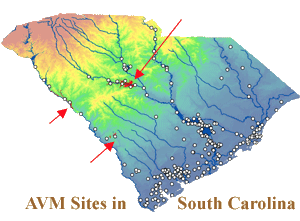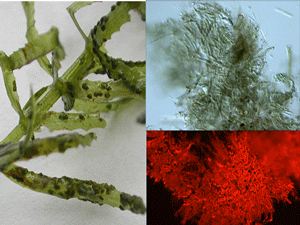South Carolina's Bald Eagles - Disease

Avian Vacuolar Myelinopathy
The introduction of hydrilla (Hydrilla verticillata) into the United States in the 1960s has been detrimental to navigation, power generation, water intake, and water quality. Our field surveys and feeding studies have now implicated exotic hydrilla and associated epiphytic cyanobacterial species as a link to avian vacuolar myelinopathy (AVM), an emerging avian disease affecting herbivorous waterbirds and their avian predators.
AVM, first reported in 1994, has caused the death of at least 100 bald eagles and thousands of American coots (Fulica americana) at 11 sites from Texas to North Carolina. Since 1994 AVM has been diagnosed in additional sites from Texas to North Carolina. AVM is the cause of the largest undiagnosed eagle mortality in U.S. history, a 1994 die-off of 30%–65% of all eagles wintering at DeGray Lake , Arkansas. AVM was first recognized at DeGray Lake and has been the confirmed or suspected cause of death of at least 100 bald eagles in southeastern U.S. reservoirs. However, because the band recovery rate for bald eagles is less than 10%, observed mortality is likely to be a small fraction of the actual number killed by AVM.
 The cause of this disease is still unknown. AVM is characterized by widespread bilaterally symmetrical vacuolation of the white matter of the brain and spinal cord of affected animals. Affected birds have difficulty flying and are uncoordinated on land and in water. Sick or dead eagles are generally found from October to March, with a peak in eagle deaths occurring from mid-November through December. Complete publication.
The cause of this disease is still unknown. AVM is characterized by widespread bilaterally symmetrical vacuolation of the white matter of the brain and spinal cord of affected animals. Affected birds have difficulty flying and are uncoordinated on land and in water. Sick or dead eagles are generally found from October to March, with a peak in eagle deaths occurring from mid-November through December. Complete publication.
The disease also has afflicted untold numbers of waterbirds, including thousands of American coots, a preferred prey of eagles. Other birds affected by AVM include Canada geese (Branta canadensis), great horned owls (Bubo virginianas), killdeer (Charadrius vociferus), mallards (Anas platyrhynchos), and ring-necked ducks (Aythya collaris). AVM also is suspected in the deaths of buffleheads (Bucephala albeola), northern shovelers (Anas clypeata), American widgeons (Anas americana), and other waterfowl. The disease has been linked through the food chain from plants to waterfowl to predators. Eagles contract AVM by preying on afflicted coots and other waterfowl unable to effectively escape. Feeding studies confirmed this link when the disease was induced in nonreleasable red-tailed hawks (Buteo jamaicensis) that were fed tissue from AVM positive coots.
West Nile Virus
West Nile Virus (WNV) was introduced into the United States in New York in 1999 and has since become permanently established throughout North America. WNV was first documented in raptors in the summer of 2002. Since that time, this disease has been diagnosed in bald eagles in South Carolina as well as other states. There are a number of factors that place eagles at elevated risk of exposure:
- The virus is transmitted between birds in the wild by mosquitoes that are abundant in preferred aquatic habitats
- WNV has been transmitted orally through ingestion of infected prey.
- An outbreak of WNV at a Canadian facility had 108 of 245 owls die from the disease. Larger species of owls had higher infection rates than smaller species and the same may be true in diurnal raptors.
- Bald eagles in the southeastern states share many habitats with alligators which have been documented as reservoirs for the disease.
Substantial effects of WNV on a population of crows and on sage grouse have been documented. Many populations of nesting eagles are closely monitored and to date, no large-scale mortality event has been recorded in any wild eagle population.
Dead birds suspected to have been killed by WNV should be reported to SCDHEC County Environmental Health Departments. View more information and a listing of DHEC County offices.
